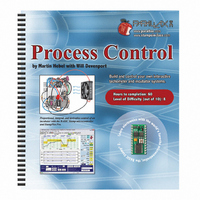122-28176 Parallax Inc, 122-28176 Datasheet - Page 261

122-28176
Manufacturer Part Number
122-28176
Description
GUIDE STUDENT PROCESS CONTROL
Manufacturer
Parallax Inc
Specifications of 122-28176
Accessory Type
Manual
Product
Microcontroller Accessories
Lead Free Status / RoHS Status
Contains lead / RoHS non-compliant
For Use With/related Products
Propeller Education (PE) Kit
Lead Free Status / RoHS Status
Lead free / RoHS Compliant, Contains lead / RoHS non-compliant
- Current page: 261 of 330
- Download datasheet (11Mb)
The derivative evaluation provides a measurement of the change in value with respect to
time (the faster the error changes, or the slope at that instant, the higher the magnitude of
the error.) At point 1 of Figure 8-2, the value is changing very rapidly with a positive
slope (rising).
(decreasing).
Analog circuits using op-amps can provide true proportional, integral and derivative drive
where the waveform is processed on a continuous basis. At any given instant, the error is
measured and processing of that error is made.
measurement is not possible. Samples are taken at intervals, and approximations are
made to provide PID control. Before we test the microcontroller performing PID control,
let's first look at a system controlled with analog PID.
Electronic Systems Technologies students, at Southern Illinois University Carbondale,
regularly construct and test the floating-ball project as shown in Figure 8-3. An infrared
beam is used to detect the position of the magnetic ball. Drive to the electromagnet is
used to control the position of the ball. The setpoint is the desired voltage representing
the light falling on the detector based on the ball partially in the beam. The actual ball
position is detected based on the amount of light striking the phototransistor and
producing an output at the collector. The error is the difference between the actual and
desired voltages. As the ball begins to drop (light level increases), drive to the magnet
must increase, and as the ball gets pulled up (light level decreases), the drive to the
magnet must be decreased. When properly adjusted, or tuned, the ball will maintain a
relatively stable position, "floating" in the beam.
At point 2, the value is changing slowly with a negative slope
In microcontrollers, instantaneous
Figure 8-3
Floating Ball
Project
Related parts for 122-28176
Image
Part Number
Description
Manufacturer
Datasheet
Request
R

Part Number:
Description:
MANUAL FOR SUMOBOT
Manufacturer:
Parallax Inc
Datasheet:

Part Number:
Description:
GUIDE STUDENT SMART SENSORS
Manufacturer:
Parallax Inc
Datasheet:

Part Number:
Description:
MANUAL PROPELLER
Manufacturer:
Parallax Inc
Datasheet:

Part Number:
Description:
LEAD WIRES FLYING CABLE III/IV
Manufacturer:
Xilinx Inc
Datasheet:

Part Number:
Description:
BOARD ADAPTER AND FLY LEADS
Manufacturer:
Xilinx Inc
Datasheet:

Part Number:
Description:
PLATFORM CABLE USB II
Manufacturer:
Xilinx Inc
Datasheet:

Part Number:
Description:
KIT STARTER COOLRUNNER-II BUNDLE
Manufacturer:
Xilinx Inc
Datasheet:

Part Number:
Description:
Microcontroller Modules & Accessories DISCONTINUED BY PARALLAX
Manufacturer:
Parallax Inc

Part Number:
Description:
Microcontroller Modules & Accessories DISCONTINUED BY PARALLAX
Manufacturer:
Parallax Inc

Part Number:
Description:
BOOK UNDERSTANDING SIGNALS
Manufacturer:
Parallax Inc
Datasheet:

Part Number:
Description:
BOARD EXPERIMENT+LCD NX-1000
Manufacturer:
Parallax Inc
Datasheet:

Part Number:
Description:
IC MCU 2K FLASH 50MHZ SO-18
Manufacturer:
Parallax Inc
Datasheet:












